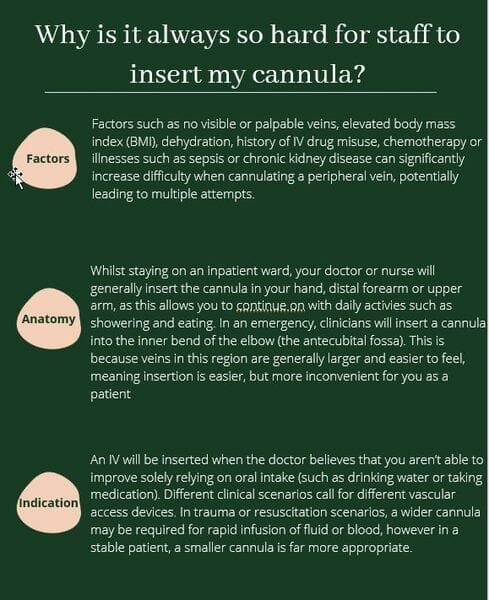Tips for PIVC Location and Size

Of the 11 million Australians accessing care in a hospital each year, an estimated 7.7 million will receive a peripheral intravenous catheter (PIVC), also called a cannula, meaning this procedure is commonplace, particularly in the emergency department.(1) Although this is such a common procedure, first-attempt failure rates are high, with an estimated 40% failure rate in adults and 65% in the paediatric population.(1)
All clinicians who are cannulation competent must be able to identify factors potentially leading to first-attempt failure.(1) Factors such as dehydration, body mass index, recent chemotherapy and if the patient is suffering from sepsis are consistent between the adult and paediatric population, however factors such as chronic kidney disease and IV drug misuse must also be considered in the adult population.(2,3) To preserve vessel health, ultrasound-guided cannulation should be used for these patients.
A favoured location for PIVC access in the emergency department is the antecubital fossa, where the basilic, cephalic and median cubital veins are located.(4) This is due to the palpability and size of the veins, allowing for both first-attempt success, and the insertion of a large bore cannula for rapid fluid resuscitation.(4, 5).
The antecubital fossa is not appropriate for inpatients, due to the inconvenient location, and the subsequent risk of dislodgement and phlebitis.(6) Most PIVCs should be inserted away from an area of flexion, such as in the hand or forearm, where the basilic and cephalic vein are still used, but now include the addition of the metacarpal vein.(4)
Cannula size can also have an impact on patient satisfaction. For example, a wide-bore cannula, such as a 14-gauge, is required in major trauma and surgical scenarios, as it can infuse up to 350 mL of fluid per minute (20 L/hr), though insertion is more painful. Whereas a standard 22-gauge cannula can infuse 35 mL of fluid per minute (2 L/hr), and is far smaller than a 14-gauge, meaning less pain for the patient.(5,7)
References
1. Australian Commission for Safety and Quality in Health Care. Management of peripheral intravenous catheters clinical care standard Sydney: ACSQHC; 2021. https://www.safetyandquality.gov.au/publications-and-resources/resource-library/management-peripheral-intravenous-catheters-clinical-care-standard
2. Nye M, Sweeny A, Watkins S, Ingold J, Sharwood P. Difficult vascular access in hospitalised patients: Delays to treatment, cannulation attempts, and use of ultrasound. Vascular Access 2020;6(1):5
3. Schults J, Rickard C, Kleidon T, Paterson R, Macfarlane F, Ullman A. Difficult peripheral venous access in children: an international survey and critical appraisal of assessment tools and escalation pathways. J Nurs Scholarsh 2019;51(5):537-546.
4. Frank R, Wolfson A, Grayzel J. Peripheral venous access in adults. uptodate.com 2020. Page updated May 14, 2020.
5. BBraun Australia. IV Cannula Pocket Guide, 2019. https://www.bbraun.com.au/en/Search.pagination.html/page-searchresults/1.html?q=flow+rate&_charset_=UTF-8&f=documents
6. Queensland Health. Peripheral Intravenous Catheter (PIVC), 2015. https://www.health.qld.gov.au/__data/assets/pdf_file/0025/444490/icare-pivcguideline.pdf
7. Rusch D, Koch T, Spies M, Eberhart L. Pain during venous cannulation. Deutsches Arzteblatt International 2017;114(37):605-611
| Tags:peripheral intravenous cathetercannulapatient experienceIV insertionvessel health |








